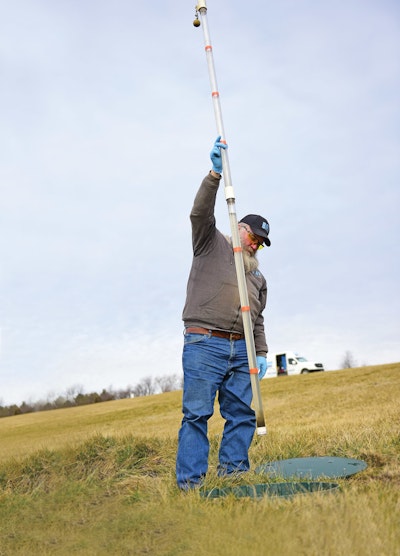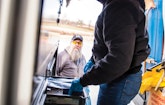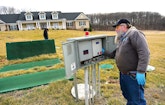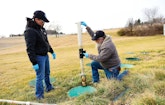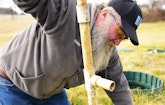In northern Maryland, BAT Onsite is fairly new on the scene. The same isn’t true of its owner, who has been building things and installing onsite systems since he was a young man. BAT Onsite is only the latest venture for Eddie Harrison who is starting a new phase of his wastewater business.
“I saw a void in the market,” he says. “And I was getting older and getting tired of shoveling gravel. I’m still young enough to shovel gravel, but I had to look to the future.”
His future no longer includes gravel. He has left behind Harrison Contracting, which did excavating along with other jobs. Instead, he formed BAT Onsite. It’s a business with a sharper focus on the market, but he can still put his deep mechanical knowledge to good use.
“I was raised in construction. My father was a bricklayer. I was on the wall at 17,” he says.
With his own company, he built homes, garages and provided excavation services. “I installed systems the whole time,” he says. He specialized in innovative onsite systems for challenging sites, and he did small municipal water and wastewater utility jobs that were too small for the big companies in his area.
With BAT Onsite, he focuses on installing and repairing advanced systems. And that means only the units themselves. He leaves the trenches and pipes to others.
Harrison, 60, started BAT Onsite in 2015 after operating the construction company since 1993. He began doing operations and maintenance in 2010 while still running the construction business, and in that year, he added 10 systems to his maintenance list. In his second year, he had about 40. By the middle of 2019, he had more than 400 systems to take care of. And he had mostly stopped installing because the service end of the business was prospering.
Good reputation
About 20 of the systems he maintains are best-available-technology (BAT) units (state approved) that he installed. All of the other work came to him because the installers or vendors didn’t want to do the maintenance. Probably 75% of his maintenance work comes from equipment vendors, he says. Other jobs have come from people who are not vendors, and some were generated by soliciting homeowners and word-of-mouth.
“And I’m getting a reputation. I get phone calls saying, ‘I’m told you’re the only guy who can fix this,’” Harrison says.
That’s why he doesn’t have a website yet, Harrison says; business appeared without an internet presence beyond a Facebook page.
BAT Onsite is not restricted to newer technologies. There are advanced systems installed more than a decade ago and sold in such small numbers that no one supports them anymore. With a phone and the internet, Harrison can find the information he needs to perform service. His background helps, too. “I was born a mechanic so it’s not hard for me to figure things out,” he says.
His business advantage is that few people are interested in service work. There is less profit in it, which means you have to do more jobs in order to make a living, he says. He sees that lack of interest in the one-day service course he teaches every year. Typically 20 to 25 people attend. Most of them already work for an existing service business that is adding technicians, and other attendees are installing and think service is a good area to expand into.
Service work also entails dealing with people who don’t understand what they have. For example, Harrison was called in to do an inspection for a customer selling a house with a troubled system, a BioMicrobics pretreatment unit leading to a Geoflow absorption field. The customer thought he just needed a new blower. Harrison found the problems went deeper.
The owner had created paddocks on his land, and one was on top of the dripfield. The weight of the horses had damaged the headworks, but fortunately not the drip tubing. The man had also built a shed, complete with footings, to hide the blower and the access hatches to the treatment unit. Harrison put in a new blower and replaced vacuum relief valves on the ends of laterals, rebuilt the headworks and did other repairs. That $6,000 worth of work was enough to get the system functioning, but six months later, the next owner had to repair some weak spots, Harrison says.
The people who sold this man the advanced system said it was high tech and worry-free, Harrison says. “Nobody told him he had to maintain it. And I deal with that on a regular basis.”
Seat at the table
Another part of Harrison’s life involves educating state legislators as legislative liaison for the Maryland Onsite Wastewater Professionals Association.
Because of water-quality issues in Chesapeake Bay, Maryland is one of the places debating the use of advanced treatment units. Tempers flared when former Gov. Martin O’Malley used an executive order in 2013 to require that BAT be used for any new construction and any system expansions.
“It really angered a lot of people on the left and the right,” Harrison says.
The rule didn’t last. Gov. Larry Hogan repealed the rule when he took office, and at the moment, the Legislature seems to be letting the issue cool off, Harrison says. But that does not mean the idea is entirely a bad one, he says.
While the BAT rule covered the entire state, not all treated wastewater reaches Chesapeake Bay. “We’re contaminating wells. We’re repairing systems that are running out of room for repairs because we have houses built in the ’70s that are on their third repair,” he says.
This battle over onsite technology looks like the automobile emissions struggles of the 1970s, Harrison says. “It’s a train coming down the track. That train is coming, and you can’t stop it.” It may take 10 years, it may take 30, but eventually all people will be required to use advanced treatment, he says.
“To me, onsite is the most efficient and safest way to dispose of wastewater,” Harrison says. That is not the same as saying it’s best in every situation. When a large number of people live in a small area, sewer systems are necessary. “But to centralize all your wastewater into one dumping point, that’s one spot where you’re putting a lot of stress on the environment,” he says. And, he adds, centralized wastewater treatment fails to recharge aquifers, instead sending water off to the oceans.
The way rules are applied can make a great difference in how they’re received, Harrison says. The original BAT regulation also required a five-year maintenance contract. (Hogan reduced that to two years, following the NSF standard.) “Property owners treated me like I was from the government. If I told them after five years that their system needed a fix, they would say, ‘Well the state put it in. They can fix it.’”
“I compare BATs to chocolate cake,” Harrison says. “The previous administration took chocolate cake and shoved it down everybody’s throat, and now everybody hates chocolate cake.”
O’Malley’s rule and the subsequent ruckus shows how important it is to be involved when laws and regulations are written. As legislative liaison for the association, that is exactly what Harrison is trying to do. He goes to meetings and attends fundraisers so local politicians will recognize his face and talk to him about wastewater issues. The Maryland Onsite Wastewater Professionals Association doesn’t pay him, he says, so technically he’s not a lobbyist.
He says the same people he now works with on legislative initiatives are the people who wrote the overaggressive BAT regulations. “They’re very good people. They have a very admirable mission to accomplish,” Harrison says. “I don’t agree with them on all that they want to do. They have a lot of influence over environmental policies. I feel we need to be part of the conversation. I’m just there to help them see whose toes they’d be stepping on if they did this or did that.”
Part of the struggle on water quality is also educating the public, he says. People who live next to Chesapeake Bay understand their wastewater affects the bay, but people who don’t live on the waterfront don’t necessarily understand that — or that their wastewater can contaminate a neighbor’s well.
The right people
For most of his business time, Harrison has worked by himself with perhaps an assistant or two. Because his new company is small, he didn’t have to go through an extensive recruiting process.
He found his office assistant, Jeannettea Williams, on Facebook and asked his friends about her experience. Hiring her was one of the best moves he has made, Harrison says; she has proved invaluable.
Technician Maria Haines, the wife of a friend, is smart and has a strong technical background as an airplane mechanic. She goes out on calls with him, but he’s considering buying a second truck to put her out on a route. Harrison’s daughter, Sarah Harrison, is a helper in the field.
Currently Harrison runs a 2019 Nissan NV2500 van, 2007 Bobcat T320 skid-steer and 2005 John Deere 410G backhoe/loader.
Harrison is looking at expanding the business by another person or two if he can find the right people. What he is not looking at is leaving the business. “I don’t ever want to retire,” he says.
Harrison has set himself up for a productive future because he can use his decades of experience to do what other people don’t necessarily want to do. Like fine gravel, he will flow into the small gaps in the market — but he doesn’t have to lift anything.
Honing your people skills
Your success in the wastewater industry can depend a great deal on how well you work with people, says Eddie Harrison, owner of BAT Onsite in Mount Airy, Maryland. “You need to have people skills,” he says. “You have to be able to recognized that glassy-eyed look that says (your customers) don’t care.”
And many property owners don’t care about onsite systems and how they work, he says. Some people want to learn, but others simply want to push a magic button and have their wastewater disappear. When you find someone with that glassy-eyed look, he says, you have to know how to wrap up the conversation without cutting them off or seeming rude. And you should try to leave them with a comment or bit of information that makes them think.
Harrison says he was lucky because he grew up in a family of storytellers. “My dad was good at telling stories, and I learned from him.” Everyone in the family could tell a story, and after you heard a tale, you would walk away wondering whether it was true. He learned to distinguish between fibs and truth and how to read people.
Your ability with people is more important in some areas of the wastewater business, he says. You don’t need it so much if you’re doing installations on new homes because you’re dealing with builders who you know and you’re dealing with fewer people.
“When you do service, you’re dealing with eight different people a day,” he says.
